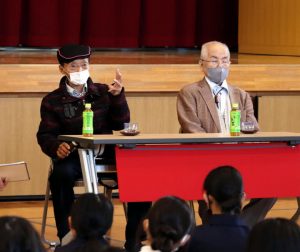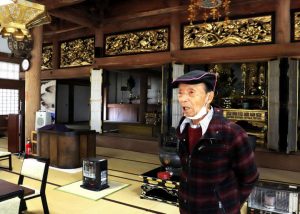A-bomb orphan Tsunehiro Tomoda, who traveled abroad, was homeless after A-bombing, told of A-bomb experience for first time at alma mater Fukuromachi Elementary School
Nov. 8, 2021
Experienced deep loneliness after group evacuation to Miyoshi City
Found charred body of younger brother in schoolyard
by Rina Yuasa, Staff Writer
Tsunehiro Tomoda, 85, a resident of Kadoma City, Osaka who experienced the atomic bombing at Fukuromachi National School (now Fukuromachi Elementary School, in Hiroshima's Naka Ward), located about 460 meters from the hypocenter, was orphaned by the atomic bombing and thereafter traveled to the Korean Peninsula. He recently visited his alma mater and shared his experience with the school’s students. During his stay in Hiroshima City, Mr. Tomoda also had an opportunity to trace the footsteps he had taken at the time of the atomic bombing. Accompanying Mr. Tomoda, this reporter gained insight into the harsh life endured by the then nine-year-old boy.
“As I was changing my shoes near the storage cabinet where shoes were kept in the basement, I was knocked over by the blast,” he explained. On October 29, Mr. Tomoda conveyed his memories of that time, when he was a fourth-grader, to about 80 fifth- and sixth-grade students at Fukuromachi Elementary School. It was the first time for Mr. Tomoda to provide his A-bomb testimony at his alma mater.
Mr. Tomoda lived with his mother, Tatsuyo, and his brother, Yukio, who was two years younger than Mr. Tomoda, after his father had died of illness. On the day of the atomic bombing, he left for school from his home at 6-chome, Otemachi (now part of Hiroshima’s Naka Ward). Yukio, who had gone to school with Mr. Tomoda, was out in the schoolyard for a morning assembly.
After the bombing, Mr. Tomoda recovered consciousness and looked around the schoolyard, only to find the bodies of Yukio and the other children charred black. “I saw the name Tomoda written on Yukio’s shoes. The whiteness of his teeth stood out grotesquely.”
Afterward, Mr. Tomoda fled in the direction of Hijiyama Hill. “A woman whose skin was melted and dangling loosely from her body was walking down from the top of the hill. There were three air-raid shelters in the area.” About 15 people were inside the shelters. Looking back on that time he said, “I spent three days there without any food or water.”
On the fourth day after the atomic bombing, he headed home along a city streetcar line. “It was frightening to walk over dead bodies.” When he finally arrived at the burned ruins of his house, he found that his charred bicycle alone managed to maintain its shape. For the first time in 76 years on his recent visit, he traced his footsteps of that day, this time in a car. When a streetcar came into view, he murmured, “Is that the Miyajima Line?” He fixed his gaze on the streetcar.
In the month before the atomic bombing, Mr. Tomoda was evacuated with others in a group to Zenryuji Temple in Miyoshi City. He visited the temple again recently, and reminisced about those days. “We all spread out our futons here and slept and upon awaking in the mornings, we wiped the corridor floors clean.”
However, his evacuation ended after only four days. He was not able to eat the locusts that were served at meals and he grew lonely. At some point, his mother and younger brother came to Miyoshi to pick him up. The memory of his younger brother saying “Let’s go home,” came back to him. If Mr. Tomoda had only stayed at the temple, they probably would not have experienced the atomic bombing at such close range. “I’m glad, though, that I was able to spend time with my family until the morning of August 6.” His eyes teared up when telling the story.
Mr. Tomoda said a turning point in his life came when he, unable to meet up his mother after the bombing, reunited with a man from Korea who had once rented a room in his home in Hiroshima. Mr. Tomoda soon travelled to the Korean Peninsula with the man, but he could not stand the harsh treatment at the hands of the man’s family. At the age of 13, he began to live on the streets, including at the foot of Hangang Bridge in Seoul. When the Korean War broke out in 1950, his life was endangered numerous times by armed conflict in the city.
Mr. Tomoda persisted in his dream of returning to Japan to see his mother. A woman who lent him a helping hand when he had lived on the streets wrote letters of petition in Japanese on behalf of Mr. Tomoda, who had forgotten almost all of his Japanese. She sent the letters to Hiroshima numerous times. Mr. Tomoda received support of the then Hiroshima Mayor Shinso Hamai and returned to Japan at age 24 in 1960, a time during which Japan and South Korea had no diplomatic relations. He learned then that his mother, Tatsuyo, had died in the atomic bombing.
After working in Hiroshima City, Mr. Tomoda moved to Osaka. He underwent surgery for stomach cancer two years ago and now lives a quiet life. On this occasion, a citizens group composed of musicians in Hiroshima asked Mr. Tomoda to take the stage at a music festival, and at the same time Fukuromachi Elementary School requested that he share his A-bomb experience with the school’s students. He accepted the requests because “I want to talk about my younger brother, who died in the schoolyard.” He also made appeals to the students. “Nuclear weapons are simply horrific. Do your best to prevent war from ever starting.” Mr. Tomoda hopes the message he delivered at Fukuromachi Elementary School resonated with the children.
(Originally published on November 8, 2021)









